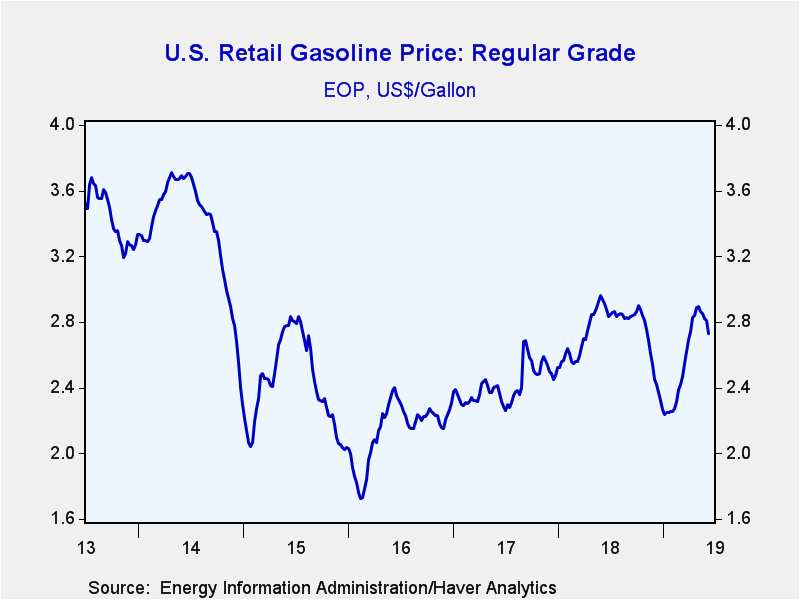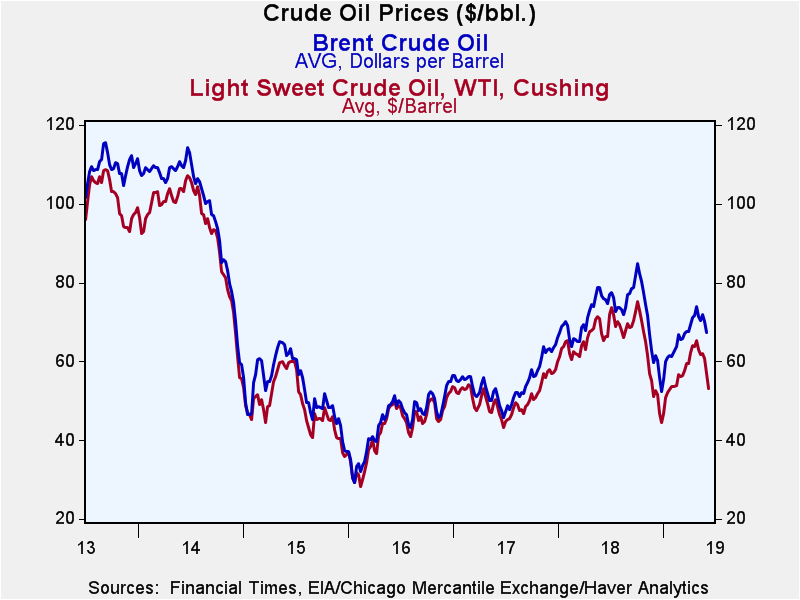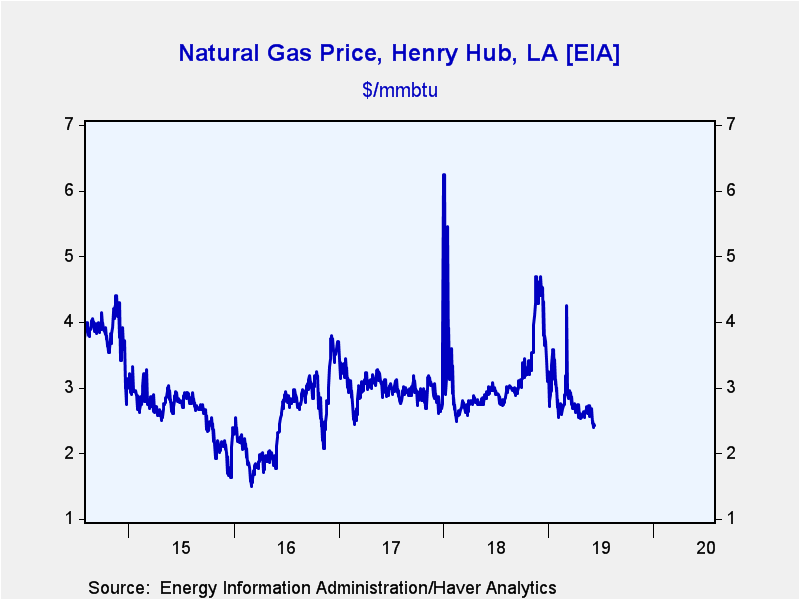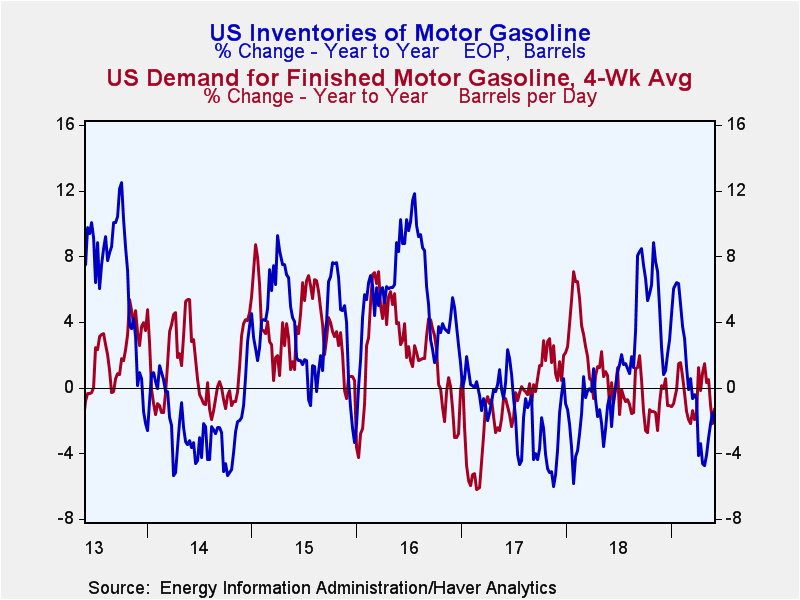 Global| Jun 11 2019
Global| Jun 11 2019U.S. Gasoline Prices Fall Further; WTI Prices Drop into Bear Market
by:Sandy Batten
|in:Economy in Brief
Summary
U.S. retail gasoline prices continued to fall in the week ended June 10, declining seven cents to $2.73 per gallon (-6.1% y/y) for their fifth consecutive weekly decline. Haver Analytics calculates factors that adjust for the seasonal [...]
U.S. retail gasoline prices continued to fall in the week ended June 10, declining seven cents to $2.73 per gallon (-6.1% y/y) for their fifth consecutive weekly decline. Haver Analytics calculates factors that adjust for the seasonal variation in gasoline pump prices. The seasonally adjusted price fell six cents to $2.57 per gallon, the lowest since the week ended March 4.
Mounting global trade tensions have dinted the outlook for the global economy and thereby have depressed the demand for energy. West Texas Intermediate crude oil prices continued to fall last week with the daily price dropping into bear-market territory (a 20% decline from most recent high of $66.24 on April 23) on June 6 before rebounding slightly on June 7. However yesterday, prices fell again to $53.26. The weekly average WTI price declined to $53.00 per barrel (-18.9% y/y) in the week ended June 7 from $56.95 the previous week. It was the lowest price since late January and the fifth weekly decline in the past six weeks. Brent crude oil prices fell sharply to an average of $61.75 per barrel last week (-18.7% y/y) from $67.29 the previous week. Prices reached a recent high of $73.82 in late April. Yesterday, the price dropped to $62.30 per barrel.
U.S. natural gas prices also fell markedly last week. They slumped to $2.45/mmbtu (-15.2% y/y) from $2.65/mmbtu the previous week and remained well below the most recent high of $4.67/mmbtu in last November. Price edged down further yesterday to $2.42.
In the four-weeks ending May 31, U.S. gasoline demand was down 1.2% y/y, while total petroleum product demand declined 0.6% y/y. U.S. gasoline inventories rose for the third consecutive week but were down 2.0% from a year ago, while inventories of all petroleum products posted their largest weekly increase in more than a decade and were up 4.4% from a year earlier. Crude oil input to U.S. refineries edged up in the week but slipped 1.2% y/y.
These data are reported by the U.S. Department of Energy. The price data can be found in Haver’s WEEKLY and DAILY databases. Greater detail on prices, as well as the demand, production and inventory data, including regional breakdowns, are in OILWKLY.
| Weekly Energy Prices | 6/10/2019 | 6/3/2019 | 5/27/2019 | Y/Y % | 2018 | 2017 | 2016 |
|---|---|---|---|---|---|---|---|
| Retail Gasoline ($ per Gallon Regular, Monday Price, End of Period) | 2.73 | 2.81 | 2.82 | -6.10 | 2.27 | 2.47 | 2.31 |
| Light Sweet Crude Oil, WTI ($ per bbl, Previous Week's Average) | 53.00 | 56.95 | 60.77 | -18.90 | 64.95 | 50.87 | 43.22 |
| Natural Gas ($/mmbtu, LA, Previous Week's Average) | 2.45 | 2.66 | 2.66 | -15.20 | 3.15 | 2.96 | 2.49 |
Sandy Batten
AuthorMore in Author Profile »Sandy Batten has more than 30 years of experience analyzing industrial economies and financial markets and a wide range of experience across the financial services sector, government, and academia. Before joining Haver Analytics, Sandy was a Vice President and Senior Economist at Citibank; Senior Credit Market Analyst at CDC Investment Management, Managing Director at Bear Stearns, and Executive Director at JPMorgan. In 2008, Sandy was named the most accurate US forecaster by the National Association for Business Economics. He is a member of the New York Forecasters Club, NABE, and the American Economic Association. Prior to his time in the financial services sector, Sandy was a Research Officer at the Federal Reserve Bank of St. Louis, Senior Staff Economist on the President’s Council of Economic Advisors, Deputy Assistant Secretary for Economic Policy at the US Treasury, and Economist at the International Monetary Fund. Sandy has taught economics at St. Louis University, Denison University, and Muskingun College. He has published numerous peer-reviewed articles in a wide range of academic publications. He has a B.A. in economics from the University of Richmond and a M.A. and Ph.D. in economics from The Ohio State University.










